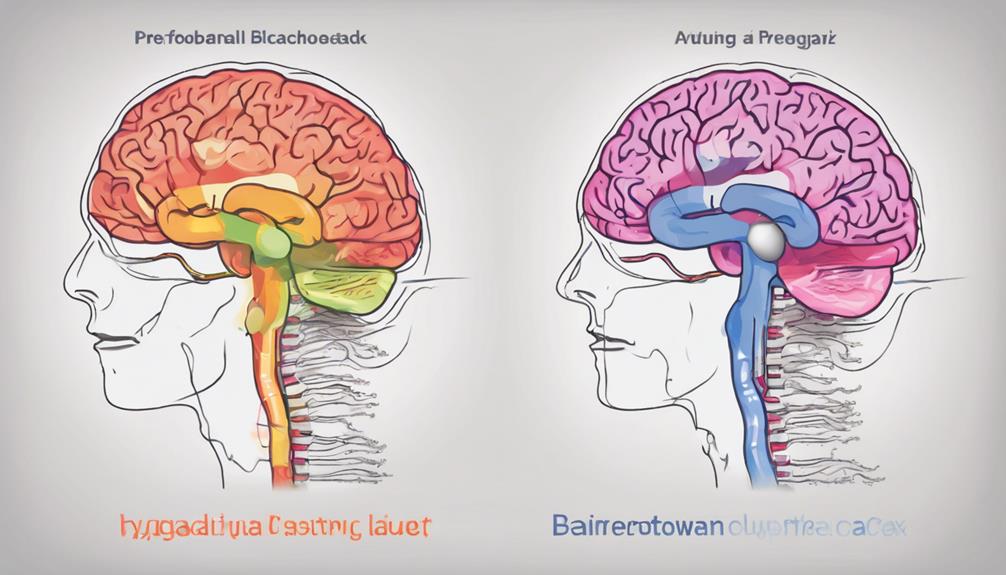Neuroscientific research reveals intricate neural correlates and brain regions involved in hypnosis. Specific neural oscillations like theta and alpha frequencies are modulated during hypnotic states, affecting cognitive processing. Brain regions such as the dorsolateral prefrontal cortex (DLPFC), anterior cingulate cortex (ACC), and insula play roles in hypnosis by regulating cognitive processes and emotions. Functional connectivity shifts occur in default mode network connectivity and theta wave synchronization during hypnosis. Altered states of consciousness in hypnotized individuals exhibit distinctive neural signatures. Additionally, hypnosis induces neuroplastic changes in brain structure and function. Understanding these discoveries deepens insight into the effects of hypnosis on brain activity.
Neural Correlates of Hypnotic States

Recent neuroscientific research has identified specific neural correlates associated with hypnotic states, shedding light on the underlying brain mechanisms involved in this intriguing phenomenon.
One key aspect that has been investigated is the role of neural oscillations in hypnotic states. Neural oscillations refer to the rhythmic activity of neurons in the brain, which play a crucial role in coordinating cognitive processes. Studies have shown that during hypnosis, there is a modulation of neural oscillations, particularly in the theta and alpha frequency bands. These changes in neural oscillations are thought to be linked to alterations in cognitive processing, such as increased attentional focus and reduced awareness of external stimuli.
Furthermore, cognitive processing during hypnosis has been a focal point of research in understanding hypnotic states. Studies have demonstrated that under hypnosis, there are changes in neural activity associated with cognitive functions like perception, memory, and suggestibility. These findings suggest that hypnosis involves a complex interplay of neural mechanisms that influence cognitive processing, highlighting the intricate relationship between brain activity and hypnotic phenomena.
Brain Regions Involved in Hypnosis
Studies exploring the brain regions involved in hypnosis have revealed specific neural networks that play a critical role in the manifestation of hypnotic phenomena. Cognitive processing, a key aspect of hypnosis, involves the activation of regions such as the dorsolateral prefrontal cortex (DLPFC), responsible for executive functions like attention and working memory.
Additionally, the anterior cingulate cortex (ACC) is implicated in monitoring cognitive processes during hypnosis, suggesting its involvement in regulating attention and focus.
Emotional regulation, another essential component of hypnosis, is linked to the activation of the insula and cingulate cortex. These regions are responsible for processing emotions and integrating emotional responses with cognitive functions, indicating their significance in modulating emotional experiences during hypnotic states.
Furthermore, the involvement of the thalamus and default mode network (DMN) in hypnosis suggests a complex interplay between cognitive, emotional, and sensory processing. Understanding the specific brain regions involved in hypnosis provides valuable insights into the neural mechanisms underlying the hypnotic experience, shedding light on the intricate relationship between cognitive processing and emotional regulation during hypnotic states.
Functional Connectivity During Hypnosis

Understanding the functional connectivity patterns observed in the brain during hypnosis provides valuable insights into the network dynamics underlying hypnotic states. Research has shown that during hypnosis, there is a shift in the brain's default mode network connectivity, which is associated with self-referential processing and mind-wandering. This alteration suggests a redirection of cognitive resources towards the hypnotic experience, leading to decreased self-referential thoughts and increased responsiveness to hypnotic suggestions.
Moreover, studies have indicated an increase in theta wave synchronization between different brain regions during hypnosis. Theta waves are associated with deep relaxation and heightened focus, which are characteristic of hypnotic states. This synchronization implies enhanced communication between brain regions involved in attention, memory, and control processes during hypnosis, facilitating the absorption of suggestions and alterations in perception.
Altered States of Consciousness in Hypnotized Individuals
The examination of altered states of consciousness in hypnotized individuals unveils distinctive neural signatures that elucidate the neurobiological underpinnings of hypnosis. During hypnosis, there are notable changes in cognitive processes such as attention, memory, and suggestibility. These alterations are reflected in the brain activity of hypnotized individuals, with studies indicating shifts in neural networks involved in cognitive control and perception.
Altered perceptions are a key feature of the hypnotic state, where individuals may experience changes in sensory processing and subjective reality. Neuroimaging studies have shown that regions associated with perception, such as the prefrontal cortex and the parietal cortex, exhibit modified activity during hypnosis. These changes in brain function provide insights into how hypnosis can influence an individual's perception of reality.
Neuroplasticity Effects of Hypnosis on the Brain

Neuroplastic changes induced by hypnosis demonstrate significant impact on the structural and functional organization of the brain. The brain's remarkable neuroplasticity mechanisms allow for modifications in response to hypnotic suggestions, resulting in observable brain plasticity effects.
Studies have shown that hypnosis can lead to alterations in brain connectivity, cortical thickness, and activity patterns, indicating a reorganization of neural networks.
Hypnosis has been found to influence various regions of the brain, including the prefrontal cortex, anterior cingulate cortex, and insula, which are associated with attention, self-awareness, and emotional processing. These changes are thought to reflect the brain's ability to adapt and rewire in response to hypnotic interventions.
Furthermore, the effects of hypnosis on neuroplasticity can persist beyond the hypnotic state, suggesting long-lasting changes in brain function. Understanding the neuroplastic changes induced by hypnosis provides valuable insights into the brain's capacity for reorganization and sheds light on the potential therapeutic applications of hypnosis for conditions involving maladaptive neural circuits.
Hypnotic Suggestions and Brain Response
Upon receiving hypnotic suggestions, the brain exhibits distinct patterns of neural activity that reflect the processing and integration of the suggested information. Cognitive processing plays a crucial role in how individuals respond to hypnotic suggestions.
When a person is in a hypnotic trance, their neural network shows alterations that are specific to the suggested content. Research indicates that different types of suggestions can elicit varied neural responses, highlighting the complexity of the brain's reaction to hypnotic cues.
Studies exploring suggestion response have found that certain brain regions are more active during hypnotic states, suggesting heightened receptivity to the given suggestions. This heightened responsiveness is thought to facilitate the adoption of new beliefs or behaviors through the power of suggestion.
Understanding the neural mechanisms underlying hypnotic suggestions can provide insights into how cognitive processes are influenced and altered during hypnosis. By investigating the neural correlates of suggestion response, researchers aim to unravel the intricate interplay between the brain and hypnotic phenomena.
Neuroimaging Techniques in Hypnosis Research

Utilizing advanced neuroimaging techniques has been instrumental in unraveling the neural mechanisms underlying hypnosis and its effects on brain activity. Functional magnetic resonance imaging (fMRI) studies have provided insights into the cortical activity associated with hypnosis, showing alterations in regions involved in attention, perception, and self-awareness. These findings suggest that hypnosis modulates cortical networks, influencing cognitive processes and subjective experiences.
Moreover, neuroimaging has revealed the involvement of subcortical structures, such as the thalamus and basal ganglia, in hypnotic states. The thalamus plays a crucial role in sensory processing and has been implicated in the regulation of consciousness during hypnosis.
On the other hand, the basal ganglia are associated with motor functions and habit formation, indicating a potential link between hypnosis and automatic behaviors.
Frequently Asked Questions
Can Hypnosis Be Used to Enhance Memory Retention?
Hypnosis can be a potential tool to enhance memory retention. Studies suggest it may improve cognitive performance and aid learning enhancement. Utilizing hypnosis techniques, individuals may experience heightened focus and recall abilities for memory-related tasks.
Are There Long-Term Effects of Hypnosis on Brain Health?
Hypnosis may have long-term effects on cognitive function and mental health. Research suggests it can enhance brain plasticity, potentially mitigating cognitive decline. Further studies are needed to comprehensively assess its impact on long-term brain health.
Does Hypnosis Have Different Effects on Various Age Groups?
Research suggests that hypnosis can impact children differently than seniors. Studies show that children may respond well to hypnotherapy for certain conditions, while seniors may benefit from cognitive enhancement and pain management through hypnosis.
Can Hypnosis Help in Reducing Chronic Pain Through Brain Activity?
Hypnosis has shown promise in pain management by potentially reducing chronic pain through modulation of brain activity. Research suggests that hypnosis can alter neural pathways involved in pain perception, offering a non-invasive approach for pain relief.
How Does Hypnosis Impact Creativity in the Brain?
Hypnosis may impact creativity by enhancing cognitive flexibility, influencing neural pathways, and promoting brain connectivity essential for creative thinking. Research suggests that hypnosis can potentially modulate brain functions to foster innovative and imaginative processes.
Conclusion
In conclusion, neuroscientific research has provided valuable insights into the brain activity associated with hypnosis. By identifying neural correlates, brain regions involved, functional connectivity, altered states of consciousness, neuroplasticity effects, and brain responses to hypnotic suggestions, researchers have deepened our understanding of the mechanisms underlying hypnosis.
Utilizing advanced neuroimaging techniques has allowed for a more in-depth exploration of the brain's response to hypnotic states, paving the way for further research in this fascinating field.


